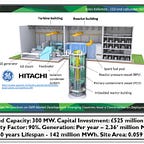In 2020, ~38 GW of WASPPs, with gas-fired backup, generated ~79 TWh of 24/7 365 electricity.
At what overnight capital cost (OCC) and Fuel cost per MWh?
Today, gas-fired plants backup wind and solar power plants (WASPPs).
At the moment, other energy storage technologies, such as Li-ion batteries, are ruled out on the grounds of cost and environmental impact.
But will it remain the case when we get to 2050. The use of natural gas will have ‘vanished’ by then and gas-fired generation, will have to be fuelled by greenH2 — if it still remains economical.
Wind Power Generation in 2020
The UK’s leading NGO for the wind power industry is ‘renewableUK’
From their website, 13,796 MW of onshore wind and 10,415 MW of offshore wind have generated 66,045,516 MWh of electricity over the 12 months.
Capacity factors for both allow calculations showing onshore wind generated 47.6% of the total and offshore wind 52.4%. It is reasonable to apply this ratio to wind power generation for the whole of 2020.
At the year’s power level of 7.75 GW, generation totals 67,890,000 MWh, resulting in:
Onshore wind — 32,315,640 MWh
Offshore wind — 35,574,360 MWh
Current overnight capital cost (OCC) of onshore wind
South Kyle Onshore Wind Farm being built at the moment, has an OCC of £320 million. From the ~170,000 homes powered it is possible to calculate South Kyle will generate 608,200 MWh/year for its 25 year lifespan.
It would take 53 South Kyles to generate 32,315,640 MWh at an OCC of £16.96 billion (equivalent to £0.68 billion/year)
Current OCC of offshore wind
Seagreen Offshore Wind Farm being built at the moment, has an OCC of £3.00 billion. From the ‘over’ 1.6 million homes powered, it is possible to calculate Seagreen will generate ~5,875,000 MWh/year for its 25 year lifespan.
It would take 6 Seagreens to generate 35,574,360 MWh at an OCC of £18.00 billion (equivalent to £0.72 billion/year)
Solar PV Generation in 2020
At the year’s power level of 1.26 GW, that totals 11,037,600 MWh
Current OCC of solar pv
Cleve Hill Solar Park has just had its plans approved to commence operation in 2022. It has an OCC of £450 million. From the ~91,000 homes powered, it is possible to calculate Cleve Hill will generate 330,000MWh/year for its 30year lifespan.
It would take 33 Cleve Hills to generate 11,037,600 MWh at an OCC of £14.85 billion (equivalent to £0.50 billion/year)
The annual cost of WASPPs at the costs of present day projects
Over 2020, WASPPs generated 78,927,600 MWh of intermittent electricity.
Total for the 2020 installed capacity of WASPPs: £1.90 billion/year
From the £1.90 billion/year, that cost is £24.07/MWh
24/7/365 electricity from WASPPs: OCC + Backup
When ‘The wind don’t blow and the Sun don’t shine’, unarguably, gas-fired backup plant is currently the most cost-effective energy storage technology (stored in the form of energy in the hydrocarbon molecules of natural gas).
Currently, that fuel cost is £7.86/MWh
£24.07/MWh + £7.86/MWh = £31.93/MWh
Note: THIS IS NOT zero-carbon electricity.
And, onto the £31.93/MWh needs to be added: Cost of capital; O & M; decommissioning; cost of waste disposal [currently unknowable] —
AND PROFIT!
NEXT UP
How does this £/MWh figure compare to the 24/7/365, zero carbon electricity from Rolls-Royce’s UK SMR?
